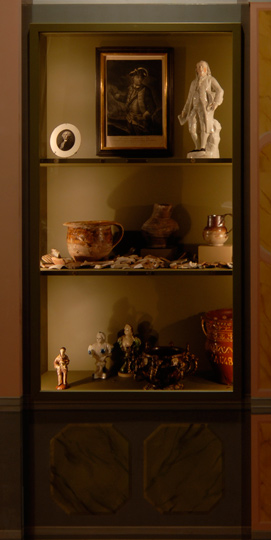
Errata: Mistakes
Blunders - Top Shelf
By 1775 General George Washington was a well-known war hero and portraits of him, like this plaque on the far left, were in high demand. Most images were relatively accurate but this odd English print in the middle is not. The artist said that the portrait was “drawn from life” but in fact Washington’s name was applied to the likeness of another person or to an entirely fictional image. Because most people still did not know what Washington looked like, this fraudulent print proved quite popular. Confusion about Washington’s appearance continued even after the United States was founded. The English ceramic painter who decorated this fi gure on the far right mixed up two famous Americans. He painted Washington’s name on a likeness of Benjamin Franklin.
Accidents - Middle Shelf
Kiln accidents plagued early potters. Ruined pieces called “kiln wasters” usually were thrown out and few examples survive today. The chamber pot on the far left probably had oxygen bubbles trapped inside that “blew out” in the kiln. Similarly, the misshapen pitcher in the middle was made with clay that was not able to withstand high heat. In this case, the pot melted just enough to make it unworthy of being decorated but not useless enough to be thrown out. Other broken pots were retrofi tted with prosthetic spouts or handles made of shaped metal such as brass, copper, or tin.
**The broken ceramic pieces on this shelf were found after World War II along the Thames River under the direction of Sir David Burnett. Many were “kiln wasters” thrown out by potters working on the south side of the Thames.
Fakes - Lower Shelf
The pottery in this cabinet is not old. These pieces were made relatively recently to be sold deceitfully as genuine antiques. The white bust of Maria Theresa, Archduchess of Austria, is a circa 1980 stone china copy that was
molded directly from an eighteenth century creamware original like the colorful example next to it. Likewise, the figure of the piper and the flower pot, with its ridiculously early date (1486!) are fakes. The six-handled tyg cleverly emulates a seventeenth century type but it was made in the late nineteenth century. Notice how its surface was mischievously patinated and distressed to look much older.
